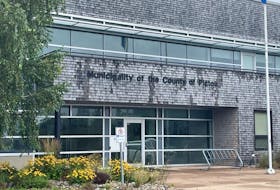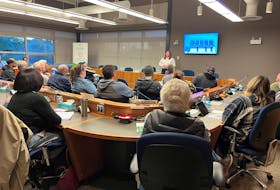AMHERST, N.S. — As he worked the bow across the strings, Flight Cpl. George Webster knew he was bringing a 100-year-old musical instrument back to life.
Webster, a member of the 250 Vimy Squadron of the Royal Canadian Air Cadets near Halifax, played several pieces on the cello made by a prisoner at Amherst’s First World War internment camp.
He was accompanied by his brothers, one playing a violin possessed by another prisoner, and the other playing his own violin.
“It sounded so good, and unique,” Webster said. “It wasn’t hard to play. It was very similar to my own cello, but the music it played was just lovely. I can only imagine the music it made more than a hundred years ago. It was a privilege to play.”

Prior to playing before more than 500 dignitaries and Amherst and Cumberland County residents, Webster had only practised once on the artifact. He made the trip to Amherst last week with his two brothers to see the cello and play it briefly at the North Nova Scotia Highlanders Regimental Museum.
The ceremony on Tuesday at the Col. James Layton Ralston Armoury marked the centennial of the camp’s closure in September 1919. It was the largest of 24 POW camps in Canada, housing, at one time, 853 prisoners in a former iron foundry.
Most of the prisoners were from the German ship SS Kaiser Wilhelm der Grosse, but the population also included people deemed as enemy aliens because they had Austro-Hungarian passports, including an unknown number of Ukrainians and Croatians.
Cumberland-Colchester MP Bill Casey came up with the idea to host the event, in part, to mark a forgotten piece of Nova Scotia history and to show how important the armoury is to the community
He was moved by the cello’s unique, if not haunting, sound.
“It sent shivers down my spine,” Casey said. “It sounded so good. I was surprised with how good it sounded. The three Webster boys who played, picked the right songs and did a great job.”
Casey was overwhelmed with the community support for the commemoration that included a brief ceremony at the Amherst Cemetery, where 13 Germans were buried until their graves were relocated to Kitchener, Ont., in 1970, as well as a performance by the German Luftwaffe Band and a display of artifacts from the community and the collections of the Cumberland County Museum, the North Nova Scotia Highlanders Regimental Museum and the Age of Sail Heritage Centre and Museum in Port Greville.
Lt.-Col. Nico Hulshoff, the German military attaché to Canada, said the commemoration is more than a celebration of the camp’s presence in Amherst, but shows how former enemies have become friends and allies.

“As a soldier I very much like the idea of bringing light to those chapters of history that not many are interested in,” he said. “Captured soldiers usually had to live under very basic conditions and sometimes waited years until the war came to an end. They didn’t play an important or heroic role in the war, so they were forgotten.
“Projects like this help give us an idea of daily life in the camp and the remarkable skills they had. This exhibition brings them closer to us and you no longer see the unknown prisoner, but the fathers, brothers and sons called to arms, captured and then spending years away from their workplaces and their loved ones.”
He said 2019 marks the 70th anniversary of NATO, the Berlin airlift that prevented the German capital from falling under Soviet control in 1949 as well as the 30th anniversary of the fall of the Berlin Wall and the end of the Cold War.
Amherst mayor David Kogon said the commemoration shows how once great enemies are now friends and allies.
“A century ago the camp was created at a time of great conflict between nations of the year. While it was labelled as the war to end all wars we all know more devastating wars followed,” Kogon said. “A hundred years later, Canada and Germany are friends, allies and trading partners and this ceremony should remind us about our joint history and remind us that war should be the last resort, and that peace can be attained between former enemies.”
Communities, Culture and Heritage Minister Leo Glavine applauded the community, Casey and the organizing committee for putting together the ceremony.
“This community and Nova Scotia is richer today, having known the history and the place of the prisoner of war camp in Amherst and in our province,” Glavine said. “Look at the creativity and the work that came out of the prisoner of war camp that remains part of the legacy 100 years later. There’s so much to celebrate and much to think about and we know this building, built in 1912, should have a strong future here in Amherst.”
Viktor Khalack, of the Ukrainian Club of Moncton, was thankful the Ukrainian internees were also remembered during the ceremony.
“Many of them were new Canadians, just getting settled in a new country far from their homeland,” Khalack said. “They were farmers and came here to work a piece of land. This was a bad part of history, but we’re very happy that Canada recognized the Ukrainian people and the German people.”
He said Canadian support of the Ukrainian people continues today with its support of the Ukrainian government that is struggling with Russian aggression in the eastern parts of its country and the Crimean Peninsula.








